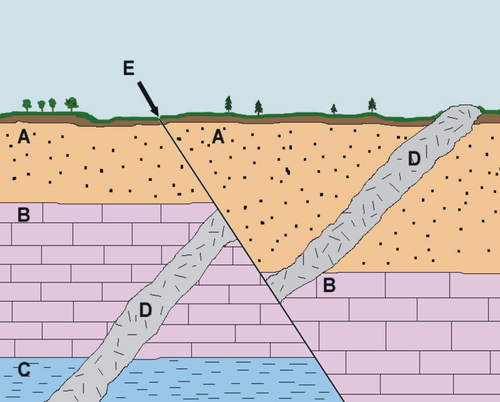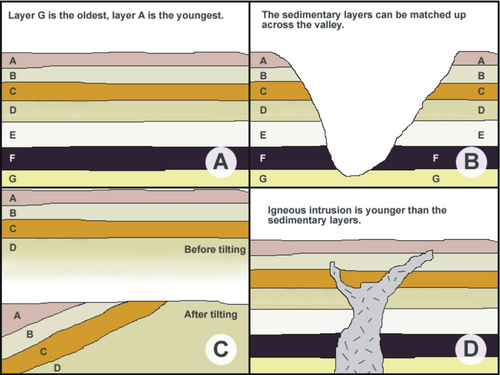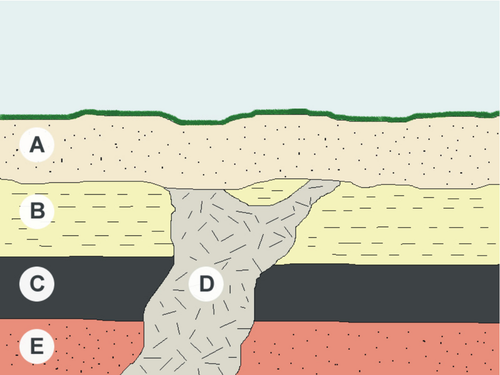Relative Ages of Rocks
In 1666, a young doctor named Nicholas Steno was invited to dissect the head of an enormous great white shark that had been caught by local fisherman near Florence, Italy. Steno was struck by the resemblance of the shark’s teeth to fossils, known as “tongue stones”, recovered from inland mountains and hills (Figure 11.9).
| Figure 11.9: Fossil shark tooth (left) and modern shark teeth (right). | |
While it may seem obvious today, most people at the time did not believe that fossils were once part of living creatures. The reason was that the fossils of clams, snails, and other marine animals were found in tall mountains, miles from any ocean. Two schools of thought explained these fossils. Some religious writers believed that the shells were washed up during the Biblical flood. But this explanation could not account for the fact that fossils were not only found on mountains, but also within mountains, in rocks that had been quarried from deep below Earth’s surface. Seeking an alternate explanation, other writers proposed that the fossils had formed within the rocks as a result of mysterious forces. In other words, fossil shells, bones, and teeth were never a part of a living creature!
Steno had other ideas. For Steno, the close resemblance between fossils and modern organisms was impossible to ignore. Instead of invoking supernatural forces to explain fossils, Steno concluded that fossils were once parts of living creatures. He then sought to explain how fossil seashells could be found in rocks far from any ocean. As in the Tyrannosaurus rex Figure 11.10, fossils resemble living organisms.
Superposition of Rock Layers
Steno first proposed that if a rock contained the fossils of marine animals, the rock was formed from sediments that were deposited on the seafloor. These rocks were then uplifted to become mountains. Based on those assumptions, Steno made a remarkable series of conjectures that are now known as Steno’s Laws.
Original Horizontality
Because sediments are deposited under water, they will form flat, horizontal layers (Figure 11.11). If a sedimentary rock is found tilted, the layer was tilted after it was formed.
Lateral Continuity
Sediments were deposited in continuous sheets that spanned the body of water that they were deposited in. When a valley cuts through sedimentary layers, it can be assumed that the rocks on either side of the valley were originally continuous.
Superposition
Sedimentary rocks are deposited one on top of another. Therefore, the youngest layers are found at the top, and the oldest layers are found at the bottom of the sequence.
Cross-Cutting Relationships
A rock formation or surface that cuts across other rock layers is younger than the rock layers it disturbs. For example, if an igneous intrusion goes through a series of metamorphic rocks, the intrusion must be younger than the metamorphic rocks that it cuts through (Figure 11.12).
The Grand Canyon provides an excellent illustration of Steno’s laws. Figure 11.13 shows the many horizontal layers of sedimentary rock that make up the canyon. This nicely illustrates the principle of original horizontality. The youngest rock layers are at the top of the canyon, while the oldest are at the bottom, which is described by the law of superposition. Distinctive rock layers, such as the Kaibab Limestone, can be matched across the broad expanse of the canyon. We know these rock layers were once connected, which is described in the rule of lateral continuity. Finally, the Colorado River cuts through all the layers of sedimentary rock to form the canyon. Based on the principle of cross-cutting relationships, the river must be younger than all of the rock layers that it cuts through.
Determining the Relative Ages of Rocks
The relative age of a rock is its age in comparison with other rocks. If you know the relative ages of two rock layers, you know which is older and which is younger, but you do not know how old the layers are in years. In some cases, it is very tricky to determine the sequence of events that leads to a certain formation. Take the example, Figure 11.14:
The principle of cross-cutting relationships states that a fault or intrusion is younger than the rocks that it cuts through. The fault labeled ‘E’ cuts through all three sedimentary rock layers (A, B, and C) and also cuts through the intrusion (D). So the fault must be the youngest formation that is seen. The intrusion (D) cuts through the three sedimentary rock layers, so it must be younger than those layers.
The principle of superposition states that the oldest sedimentary rock units are at the bottom, and the youngest are at the top. Based on this, layer C is oldest, followed by B and A. So the full sequence of events is as follows:
- Layer C formed.
- Layer B formed.
- Layer A formed.
- When layers A-B-C were present, intrusion D formed.
- Intrusion D cut through layers A-C.
- Fault E formed, shifting rocks A through C and intrusion D.
- Weathering and erosion occurred, forming a layer of soil on top of layer A.
Unconformities in Rock Layers
Steno discovered the rules for determining the relative age of rock beds, but he did not have a good understanding of how long it would take for these rock formations to form. At the time, most Europeans believed that the Earth was around 6,000 years old, a figure that was based on the amount of time estimated for the events described in the Bible. One of the first to question this time scale was a Scottish geologist named James Hutton (1726-1797). Often described as the founder of modern geology, Hutton formulated a philosophy called uniformitarianism: The present is the key to the past. According to uniformitarianism, the same processes we see around us today operated in the past as well. For example, if erosion and deposition occur slowly now, they probably have always occurred slowly.
Hutton discovered places where sedimentary rock beds lie on an eroded surface. Such a formation is called an unconformity, or a gap in rock layers, where some rocks were eroded away. Hutton reconstructed the sequence of events that led to this formation. For example, consider the famous unconformity at Siccar Point, on the coast of Scotland (Figure 11.15).
Based on figure 15, at least nine geological events can be inferred:
- A series of sedimentary beds is deposited on an ocean floor.
- The sediments harden into sedimentary rock.
- The sedimentary rocks are uplifted and tilted, exposing them above the ocean surface.
- The tilted beds are eroded by rain, ice, and wind to form an irregular surface.
- A sea covers the eroded sedimentary rock layers.
- New sedimentary layers are deposited.
- The new layers harden into sedimentary rock.
- These layers are tilted.
- Uplift occurs, exposing the new sedimentary rocks above the ocean surface.
Hutton realized that an enormous period of time was needed to account for the repeated episodes of deposition, rock formation, uplift, and erosion that led to the formation of an unconformity, like the one at Siccar Point. Hutton realized that the age of Earth should not be measured in thousands of years, but millions of years.
Matching Rock Layers
Superposition and cross-cutting are helpful when rocks are touching one another, but are useless when rocks are kilometers or even continents apart. Three kinds of clues help geologists match rock layers across great distances. The first is the fact that some sedimentary rock formations span vast distances, recognizable across large regions. For example, the Pierre Shale formation can be recognized across the Great Plains, from New Mexico to North Dakota. The famous White Cliffs of Dover in southwest England can be matched to similar white cliffs in Denmark and Germany.
A second clue could be the presence of a key bed, or a particularly distinctive layer of rock that can be recognized across a large area. Volcanic ash flows are often useful as key beds because they are widespread and easy to identify. Probably the most famous example of a key bed is a layer of clay found at the boundary between the Cretaceous Period and the Tertiary Period, the time that the dinosaurs went extinct (Figure 11.16). This thin layer of sediment, only a few centimeters thick, contains a high concentration of the element iridium. Iridium is rare on Earth but common in asteroids. In 1980, a team of scientists led by Luis Alvarez and his son Walter proposed that a huge asteroid struck Earth about 66 million years ago, causing forest fires, acid rain, and climate change that wiped out the dinosaurs.
A third type of clue that helps scientists compare different rock layers is index fossils. Recall that index fossils are the remains of organisms that were widespread but only existed for a relatively short period of time. If two rock units both contain the same type of index fossil, their age is probably very similar.
As scientists collected fossils from all over the world, they recognized that rocks of different ages contain distinctive types of fossils. This pattern led to the creation of the geologic time scale and helped to inspire Darwin’s theory of evolution (Figure 11.17).
Each era, period, and epoch of the geologic time scale is defined by the fossils that appeared at that time. For example, Paleozoic rocks typically contain trilobites, brachiopods, and crinoid fossils. The presence of dinosaur bones indicate that a rock is from the Mesozoic era, and the particular type of dinosaur will allow the rock to be identified as Triassic, Jurassic, or Cretaceous. The Cenozoic Era is also known as the Age of Mammals, and the Quaternary Period represents the time when the first humans spread across Earth.
Lesson Summary
Nicholas Steno first formulated the principles that allow scientists to determine the relative ages of rocks in the 17th century. Steno stated that sedimentary rocks are formed in continuous, horizontal layers, with younger layers on top of older layers. A century later, James Hutton discovered the law of cross-cutting relationships: a fault or igneous intrusion is younger than the rocks that it cuts through. Hutton also was the first to realize the vast amounts of time that would be needed to create an unconformity, a place where sedimentary rocks lie above an eroded surface.
Other methods come into play when comparing rock layers that are separated by a large distance. Many sedimentary rock formations are large and can be recognized across a region. Distinctive rock layers, called key beds, are also useful for correlating rock units. Fossils, especially index fossils, are the most useful way to compare different rock layers. Changes of fossils over time led to the development of the geologic time scale.
Review Questions
- In the 15th century, a farmer finds a rock that looks exactly like a clamshell. What did the farmer probably conclude about how the fossil got there?
- Which of Steno’s Laws is illustrated by each of the following images in Figure 11.18?
- What is the sequence of rock units in Figure 11.19, from oldest to youngest?
- What kind of geological formation is shown in the outcrop in Figure 11.20, and what sequence of events does it represent?
- The three outcrops in Figure 11.21 are very far apart. Based on what you see, which fossil is an index fossil, and why?
Vocabulary
- cross-cutting relationships
- One of Steno’s principles that states that an intrusion or fault is younger than the rocks that it cuts through.
- geologic time scale
- A division of Earth’s history into blocks of time distinguished by geologic and evolutionary events.
- key bed
- A distinctive, widespread rock layer that formed at a single time.
- lateral continuity
- One of Steno’s principles that states that a sedimentary rock layer extends sideways as wide as the basin in which it forms.
- original horizontality
- One of Steno’s principles that states that sedimentary layers were horizontal or flat lying at the time they were deposited.
- relative age
- The age of an object in comparison with the age of other objects.
- superposition
- One of Steno’s principles that states that in a sequence of sedimentary rock layers, the oldest layer is at the bottom and the youngest layer is at the top.
- unconformity
- A boundary between rocks of very different ages. Unconformities are often marked by an erosional surface.
- uniformitarianism
- The idea that the geologic processes that shape the land today have acted in basically the same way throughout Earth’s history.
Points to Consider
- In Nicholas Steno’s time, why didn’t most people believe the fossils were the remains of ancient organisms?
- How did Steno explain the presence of marine fossils in high mountains?
- What was the significance of unconformities to James Hutton?
- How can you determine the relative age of two rock layers that are very far apart?















